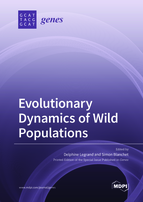Evolutionary Dynamics of Wild Populations
A special issue of Genes (ISSN 2073-4425). This special issue belongs to the section "Population and Evolutionary Genetics and Genomics".
Deadline for manuscript submissions: closed (30 November 2020) | Viewed by 33781
Special Issue Editors
Interests: evolutionary ecology; genomics; dispersal; freshwater microbiology; experimental evolution; metapopulation dynamics
Interests: freshwater biology; evolutionary ecology; host–parasite interactions; non-genetic inheritance; community and ecosystem ecology; eco-evolutionary dynamics
Special Issues, Collections and Topics in MDPI journals
Special Issue Information
Dear Colleagues,
Wild populations are facing rapid and sometimes extreme environmental changes that are currently exacerbated by pressing human activities. A major scientific endeavor is to unravel the evolutionary processes allowing wild populations to adequately respond to these rapid and drastic environmental changes. In recent decades, the accumulation of empirical data as well as the development of new theories and molecular tools have largely improved our ability to tackle such a major question. In particular, there is now growing evidence that evolutionary processes (gene flow, drift, mutation, and natural selection) interact in sometimes complex ways to shape the rapid responses of organisms to changing environments, and this can lead to unexpected feedback between evolutionary and ecological dynamics. These rapid responses are sustained by genetic determinants in addition to alternative inheritance systems, including epigenetic and/or social avatars of information. Unravelling these underlying molecular mechanisms may change the design of management and conservation plans for wild populations.
In this Special Issue, we aim to present these novel research avenues on the evolutionary dynamics of wild populations so as to generate a general overview of the most up-to-date and fascinating studies. We specifically aim to integrate experimental, observational, and theoretical studies on wild populations that focus on (i) the role of dispersal as a process sustaining metapopulation dynamics in spatially structured landscapes, (ii) the genetic and non-genetic (including epigenetic) bases of adaptation, (iii) the reciprocal links between evolutionary and ecological dynamics over contemporary timescales, and (iv) the genomic and epigenomic conservation of wild populations.
Dr. Delphine Legrand
Dr. Simon Blanchet
Guest Editors
Manuscript Submission Information
Manuscripts should be submitted online at www.mdpi.com by registering and logging in to this website. Once you are registered, click here to go to the submission form. Manuscripts can be submitted until the deadline. All submissions that pass pre-check are peer-reviewed. Accepted papers will be published continuously in the journal (as soon as accepted) and will be listed together on the special issue website. Research articles, review articles as well as short communications are invited. For planned papers, a title and short abstract (about 100 words) can be sent to the Editorial Office for announcement on this website.
Submitted manuscripts should not have been published previously, nor be under consideration for publication elsewhere (except conference proceedings papers). All manuscripts are thoroughly refereed through a single-blind peer-review process. A guide for authors and other relevant information for submission of manuscripts is available on the Instructions for Authors page. Genes is an international peer-reviewed open access monthly journal published by MDPI.
Please visit the Instructions for Authors page before submitting a manuscript. The Article Processing Charge (APC) for publication in this open access journal is 2600 CHF (Swiss Francs). Submitted papers should be well formatted and use good English. Authors may use MDPI's English editing service prior to publication or during author revisions.
Keywords
- eco-evolutionary dynamics
- wild populations
- heritability
- quantitative genetics
- dispersal
- biodiversity
- global change








